List of wine-producing regions

Wines are produced in significant growing regions where vineyards are planted. Wine grapes mostly grow between the 30th and the 50th degrees of latitude, in both the Northern and Southern Hemispheres, typically in regions of Mediterranean climate. Grapes will sometimes grow beyond this range, thus minor amounts of wine are made in some rather unexpected places.
In 2021, the five largest producers of wine in the world were, in order, Italy, France, Spain, the United States, and China.
Countries
[edit]Top wine-producing countries and their volume of wine production for the year 2021 in tonnes, according to the Food and Agriculture Organization (FAO), which is an agency of the United Nations; this is the latest information available from the FAO.
Their data show a total worldwide production of 27 million tonnes of wine with the top 15 producing countries accounting for over 90% of the total.[2]
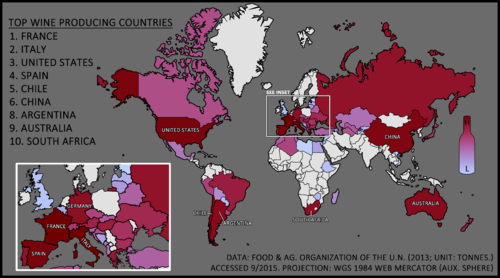
| Rank | Country | Production (tonnes) |
|---|---|---|
| 1 | Italy | 5,088,500 |
| 2 | France | 3,713,200 |
| 3 | Spain | 3,700,588 |
| 4 | United States | 2,057,021 |
| 5 | China | 1,814,400 |
| 6 | Australia | 1,482,000 |
| 7 | Chile | 1,343,729 |
| 8 | Argentina | 1,248,155 |
| 9 | South Africa | 1,133,300 |
| 10 | Portugal | 718,547 |
| 11 | Romania | 530,000 |
| 12 | Germany | 452,693 |
| 13 | Russia | 450,000 |
| 14 | Brazil | 348,449 |
| 15 | Hungary | 310,000 |
| 16 | Greece | 290,000 |
| 17 | Turkey | 266,962 |
| 18 | New Zealand | 266,400 |
| 19 | Austria | 246,000 |
| 20 | Moldova | 167,500 |
| 21 | Georgia | 119,617 |
| 22 | North Macedonia | 93,600 |
| 23 | Bulgaria | 82,300 |
| 24 | Peru | 81,000 |
| 25 | Uruguay | 74,865 |
| 26 | Ukraine | 68,470 |
| 27 | Croatia | 66,000 |
| 28 | Canada | 65,357 |
| 29 | Switzerland | 60,904 |
| 30 | Czechia | 59,000 |
| 31 | Turkmenistan | 52,098 |
| 32 | Japan | 49,473 |
| 33 | Mexico | 43,268 |
| 34 | Morocco | 43,083 |
| 35 | Tunisia | 28,000 |
| 36 | Serbia | 26,550 |
| 37 | Belarus | 26,430 |
| 38 | Kazakhstan | 23,343 |
| 39 | Vietnam | 18,153 |
| 40 | Belgium | 17,496 |
| 41 | Uzbekistan | 16,899 |
| 42 | Armenia | 12,829 |
| 43 | Slovenia | 10,192 |
| 44 | Azerbaijan | 10,116 |
| 45 | Montenegro | 10,022 |
| 46 | Luxembourg | 9,800 |
| 47 | Cyprus | 8,900 |
| 48 | Bolivia | 8,400 |
| 49 | Madagascar | 7,791 |
| 50 | Slovakia | 7,711 |
| 51 | Bosnia and Herzegovina | 5,677 |
| 52 | Egypt | 4,775 |
| 53 | Saint Lucia | 4,449 |
| 54 | Lithuania | 4,143 |
| 55 | Mauritius | 3,166 |
| 56 | Colombia | 2,606 |
| 57 | Albania | 2,587 |
| 58 | Latvia | 2,569 |
| 59 | Kyrgyzstan | 2,316 |
| 60 | Estonia | 2,088 |
| 61 | Israel | 2,020 |
| 62 | Paraguay | 1,981 |
| 63 | Lebanon | 932 |
| 64 | Jordan | 557 |
| 65 | Thailand | 461 |
| 66 | Mongolia | 371 |
| 67 | United Kingdom | 354 |
| 68 | Tajikistan | 182 |
| 69 | Panama | 108 |
Africa
[edit]Algeria
[edit]- Algiers[citation needed]
- Béjaïa[citation needed]
- Chlef Province
- Mascara[3]
- Médéa[3]
- Tlemcen[3]
- Zaccar[3]
Cape Verde
[edit]Morocco
[edit]See also: Moroccan wine
South Africa
[edit]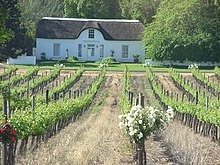
- Breede River Valley
- Constantia
- Durbanville
- Elgin
- Elim
- Franschhoek
- Little Karoo
- Orange River Valley
- Paarl
- Robertson
- Stellenbosch
- Swartland
- Tulbagh
Tunisia
[edit]See also: Tunisian wine
South America
[edit]Argentina
[edit]
- Buenos Aires Province
- Catamarca Province
- La Rioja Province
- Mendoza Province
- Neuquén Province
- Río Negro Province
- Salta Province
- San Juan Province
Bolivia
[edit]Brazil
[edit]Chile
[edit]- Aconcagua
- Atacama
- Central Valley
- Coquimbo
- Pica – a wine-producing oasis before the Chilenization of Tarapacá
- Southern Chile
Colombia
[edit]Peru
[edit]- Arequipa region valleys
- Huaral District and Cañete Province – both in Lima Region; formerly in Surco were vineyards that have disappeared due to urban expansion
- Ica Region – including Chincha, Pisco and Ica valleys
- Pica – a wine-producing oasis before the Chilenization of Tarapacá
Uruguay
[edit]Venezuela
[edit]- The wine-producing enterprise for Venezuela can be found here.
North America
[edit]Canada
[edit]- British Columbia
- Fraser Valley (VQA defined viticultural area)
- Gulf Islands (VQA defined viticultural area)
- Okanagan Valley (VQA defined viticultural area)
- Similkameen Valley (VQA defined viticultural area)
- Thompson Valley (wine region) (VQA defined viticultural area)
- Vancouver Island (VQA defined viticultural area)
- Nova Scotia
- Ontario
- Lake Erie North Shore and Pelee Island (VQA defined viticultural area)
- Niagara Peninsula (VQA defined viticultural area)
- Prince Edward County (VQA defined viticultural area)
- Toronto
- Quebec
Costa Rica
[edit]Mexico
[edit]- Aguascalientes
- Aguascalientes Valley
- Baja California
- Coahuila / Durango, collectively known as La Laguna wine region
- Guanajuato
- Hidalgo
- Nuevo León
- Querétaro
- Sonora
- Zacatecas
United States
[edit]- Arizona
- California
- Colorado
- Idaho
- Michigan
- Missouri
- New Jersey
- New Mexico
- New York
- Oregon
- Pennsylvania
- Texas
- Virginia
- Washington
Europe
[edit]Albania
[edit]Austria
[edit]- Burgenland
- Northeastern and eastern Lower Austria
- Southern Styria
- Vienna and surrounding area
Belgium
[edit]- Côtes de Sambre et Meuse, between the rivers Sambre et Meuse, since 2004
- Hagelandse wijn, near Rotselaar/Leuven, since 1997
- Haspengouw, Limburg, since 2000
- Heuvelland, since 2005
- Province of Brabant area
- Hainaut area
- Liège area
- Namur area
Bosnia and Herzegovina
[edit]Bulgaria
[edit]- Black Sea region
- Danubian Plain
- Rose Valley
- Thrace
- Valley of the Struma River
Croatia
[edit]- Continental Croatia: Central Croatia and Slavonia
- Littoral Croatia: Northern Croatian Littoral and Dalmatia
- Croatian Coast (Hrvatsko primorje)
- Dalmatian Interior (Dalmatinska zagora)
- Central and South Dalmatia (Srednja i Južna Dalmacija)
- Northern Dalmatia (Sjeverna Dalmacija)
- Istria (Istra)
Cyprus
[edit]- Commandaria
- Laona – Akamas
- Vouni Panagias – Ambelitis
- Krasochoria Lemesou
- Pitsilia
- Diarizos Valley
Czech Republic
[edit]Denmark
[edit]Estonia
[edit]- West Estonian archipelago area
- Viljandi area
- Võru area
France
[edit]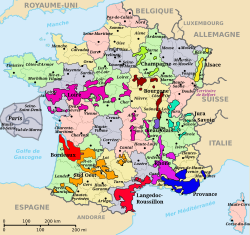

- Alsace – Alsace wine
- Bordeaux – Bordeaux wine
- Burgundy (Bourgogne) – Burgundy wine
- Champagne – Champagne
- Corsica
- Ajaccio
- Cap Course
- Patrimonio
- Vin de Corse
- Calvi
- Figari
- Porto-Vecchio
- Sartène
- Jura – Jura wine
- Languedoc-Roussillon
- Loire Valley – Loire Valley (wine region)
- Lorraine
- Madiran
- Provence
- Rhône – Rhône wine
- Savoy
Georgia
[edit]- Abkhazia
- Kakheti, containing the micro-regions Telavi and Kvareli
- Kartli
- Imereti
- Racha-Lechkhumi and Kvemo Svaneti
Germany
[edit]- Ahr
- Baden
- Franconia (Franken)
- Hessische Bergstraße
- Mittelrhein
- Mosel
- Nahe
- Palatinate (Pfalz)
- Rheingau
- Rheinhessen
- Saale-Unstrut
- Saxony (Sachsen)
- Württemberg
Greece
[edit]
- Aegean islands
- Central Greece
- Ionian Islands
- Macedonia
- Peloponnesus
Hungary
[edit]
Ireland
[edit]See also: Irish wine
Italy
[edit]
- Apulia
- Calabria
- Campania
- Avellino
- Aglianico
- Falanghina
- Fiano
- Greco di Tufo
- Benevento
- Aglianico
- Falanghina
- Solopaca
- Caserta
- Napoli
- Salerno
- Avellino
- Emilia-Romagna
- Liguria
- Lombardy
- Marche
- Piedmont
- Sardinia
- Sicily
- Trentino-Alto Adige
- South Tyrol, known alternatively as Südtirol (in German) or Alto Adige (in Italian)
- Trentino
- Tuscany
- Umbria
- Veneto
Latvia
[edit]- Sabile
- Courland area
- Semigallia area
Lithuania
[edit]- Anykščių vynas – Anykščiai area
- Mėmelio vynas – Priekulė area
Luxembourg
[edit]Moldova
[edit]Montenegro
[edit]See also: Montenegrin wine
Netherlands
[edit]North Macedonia
[edit]Norway
[edit]- Mostly Viken and Vestfold og Telemark
- Sognefjord
Poland
[edit]Portugal
[edit]
- Alentejo
- Bairrada
- Bucelas
- Carcavelos
- Colares
- Dão
- Lagoa
- Lagos
- Madeira
- Portimão
- Porto e Douro
- Setúbal
- Tavira
- Vinhos Verdes
Romania
[edit]- Dobrogea wine regions:
- Moldavia wine regions:
- Muntenia wine regions:
- Oltenia wine regions:
- Transylvania wine regions:
Russia
[edit]This section needs expansion. You can help by adding to it. (June 2008) |
San Marino
[edit]Serbia
[edit]
- Banat region
- Nišava – South Morava region
- Pocerina region
- Srem region
- Subotica – Horgoš region
- Šumadija – Great Morava region
- Timok Valley
- West Morava region
Slovakia
[edit]
- Malokarpatská (Small Carpathians)
- Južnoslovenská (Southern Slovakia)
- Nitrianska (region of Nitra)
- Stredoslovenská (Central Slovakia)
- Tokaj (Tokaj region of Slovakia)
- Východoslovenská (Eastern Slovakia)
- The whole of southern Slovakia
Slovenia
[edit]
Spain
[edit]
- Andalusia
- Aragon
- Balearic Islands
- Basque Country
- Canary Islands
- Castile and León
- Castile–La Mancha
- Catalonia
- Extremadura
- Galicia
- La Rioja
- Community of Madrid
- Región de Murcia
- Navarre
- Valencian Community
Sweden
[edit]- Gutevin – Gotland
Switzerland
[edit]- Aargau[5]
- Bern[6]
- Freiburg[7]
- Geneva
- Grisons
- Neuchâtel
- St. Gallen[8]
- Schaffhausen[9]
- Thurgau[10]
- Ticino
- Valais
- Vaud
- Zürich[11]
Turkey
[edit]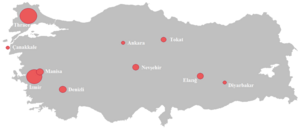
- White wine grapes:[12]
- Red wine grapes[12]
- Adakarası – Marmara region and Avşa Island
- Boğazkere – Elazığ and Diyarbakır areas
- Çalkarası – Çal, Denizli area
- Dimrit – central Anatolia and eastern Aegean region
- Horozkarası, Sergikarası – southeastern Anatolia region
- Kalecik Karası – Ankara area
- Karalahna – Tekirdağ region, Bozcaada
- Karasakız, Kuntra – Çanakkale region
- Öküzgözü – Elazığ area
- Papazkarası – Kırklareli area
Ukraine
[edit]In Ukraine, at the present time there are seven administrative regions (provinces) in which the wine industry has developed. Given the favorable climatic location, the law of Ukraine allocated 15 winegrowing areas (macrozones), which are the basis for growing certain varieties of grapes, and 58 natural wine regions (microzones). These are located mainly in the following areas.
- Autonomous Republic of Crimea and Sevastopol – 6 macrozones with 12 microzones (69 wine grapes)
- Kherson Oblast – 2 macrozones with 10 microzones (28 wine grapes)
- Mykolaiv Oblast – 2 macrozones with 7 microzones (31 wine grapes)
- Odesa Oblast – 3 macrozones with 16 microzones (42 wine grapes)
- Zakarpattia Oblast – 1 macrozone with 12 microzones (24 wine grapes)
- Zaporizhzhia Oblast – 1 macrozone with 1 microzone (5 wine grapes)
United Kingdom
[edit]In the UK, the area under vines is small, and whilst viticulture is not a major part of the rural economy, significant planting of new vines has occurred in the early 21st century. The greatest concentration of vineyards is found in the south east of England, in the counties of Hampshire, Kent, Surrey, and Sussex.
Asia
[edit]Armenia
[edit]- Ararat Valley
- Areni, in the Vayots Dzor Province
- Ijevan, in the Tavush Province
Azerbaijan
[edit]- Aghdam, Agdam District
- Baku, capital
- Ganja, Ganja-Basar zone in central Azerbaijan
- Madrasa village of Shamakhi Rayon, from Madrasa, indigenous only to this region
- Tovuz and Shamkir, northwestern Azerbaijan
Burma
[edit]China
[edit]Regions producing native wines have been present since the Qin dynasty,[13] with wines being brought to China from Persia. Some of the more famous wine-producing regions are:
With the import of Western wine-making technologies, especially French technology, production of wines similar to modern French wine has begun in many parts of China with the direction of experienced French wine-makers; China is now the sixth largest producer of wine in the world. The following regions produce significant quality of wine:
- Chang'an[14]
- Dalian, Liaoning[14]
- Tonghua, Jilin[14]
- Yantai, Shandong[15]
- Yibin, Sichuan[14]
- Zhangjiakou, Hebei[14]
India
[edit]- Nashik, Maharashtra
- Bangalore, Karnataka
- Vijayapura, Karnataka
- Narayangaon
- Pune, Maharashtra
- Sangli, Maharashtra
Indonesia
[edit]Indonesia has been producing wine for over 18 years, with North Bali's vineyards producing three main grape varieties: the Belgia, the Alphonse Lavallee and the Probolinggo Biru. The main producer, Hatten Wines, has revolutionized the world of winemaking, with eight wines produced from these three varieties.
Iran
[edit]Prior to the Iranian Islamic Revolution of 1979, Iran was a producer of wine. While production has stopped, the vineyards continue to exist and their product has been diverted to non-alcoholic purposes.
Israel
[edit]Also includes wine regions in Israeli-occupied territories.
- Galilee
- Golan Heights
- Judean Hills
- Mount Carmel
- Rishon LeZion (wine production since 1886)
Japan
[edit]Kazakhstan
[edit]South Korea
[edit]- Anseong, Gyeonggi-do[16]
- Gimcheon, Gyeongsangbuk-do
- Gyeongsan, Gyeongsangbuk-do
- Yeongcheon, Gyeongsangbuk-do
- Yeongdong, Chungcheongbuk-do[17]
Lebanon
[edit]Palestinian territories
[edit]Syria
[edit]See also: Syrian wine
Turkey
[edit]
- White wine grapes:[12]
- Red wine grapes[12]
- Adakarası – Marmara region and Avşa Island
- Boğazkere – Elazığ and Diyarbakır areas
- Çalkarası – Çal, Denizli area
- Dimrit – central Anatolia and eastern Aegean region
- Horozkarası, Sergikarası – southeastern Anatolia region
- Kalecik Karası – Ankara area
- Karalahna – Tekirdağ region, Bozcaada
- Karasakız, Kuntra – Çanakkale region
- Öküzgözü – Elazığ area
- Papazkarası – Kırklareli area
Vietnam
[edit]Oceania
[edit]Australia
[edit]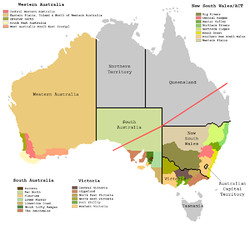
Geographic indications for Australian wine are governed by law. The geographic indication must indicate where the grapes are grown, irrespective of where the wine itself is made. A geographic indication may be "Australia", "South Eastern Australia", a state name, zone, region or subregion if defined.[18]
The zones, regions and subregions in each state are listed below:
Australian Capital Territory
[edit]
New South Wales
[edit]- Big Rivers
- Central Ranges
- Hunter Valley
- Northern Rivers
- Northern Tablelands
- South Coast
- Southern New South Wales
- Canberra District (includes the northern part of the Australian Capital Territory)
- Gundagai
- Hilltops
- Tumbarumba
Queensland
[edit]South Australia
[edit]Adelaide Super Zone includes Mount Lofty Ranges, Fleurieu and Barossa wine zones.
Tasmania
[edit]- Regions, no zones defined
- Coal River
- Derwent Valley
- East Coast
- North West
- Pipers River
- Southern
- Tamar Valley
Victoria
[edit]- Central Victoria
- Gippsland
- North East Victoria
- North West Victoria
- Port Phillip
- Western Victoria
Western Australia
[edit]- Greater Perth
- South Western Australia
New Zealand
[edit]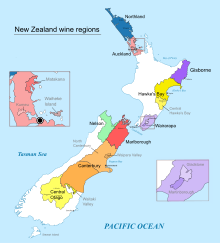
GI stands for New Zealand Geographical Indication.
- Auckland (GI)
- Henderson
- Kumeu (GI)
- Matakana (GI)
- Waiheke Island (GI)
- Canterbury (GI)
- North Canterbury (GI)
- Waipara Valley (GI)
- Central Otago (GI)
- Bendigo
- Bannockburn (GI)
- Gibbston
- Wānaka
- Gisborne (GI)
- Hawke's Bay (GI)
- Marlborough (GI)
- Nelson (GI)
- Northland (GI)
- Waikato (Te Kauwhata)
- Wairarapa (GI)
- Martinborough (GI)
- Gladstone (GI)
- Waitaki Valley (GI)
References
[edit]- ^ "Wine production". Our World in Data. Retrieved 5 March 2020.
- ^ "Wine production in 2021, Crops/Regions/World list/Production Quantity/Year (pick lists)". UN Food and Agriculture Organization, Corporate Statistical Database (FAOSTAT). 2024. Retrieved 10 June 2024.
- ^ a b c d e "The History of Vineyards in Algeria". Atlasian Cellars Meghdir & Sons. 2005. Retrieved 2005-04-07.
- ^ "#VisitCzechia". May 2024.
- ^ "Schweiz Aargau und seine Weingebiete". www.ernestopauli.ch. Archived from the original on 2011-05-12. Retrieved 2015-07-30.
- ^ "Schweiz Bern und seine Weingebiete". www.ernestopauli.ch. Archived from the original on 2015-09-03. Retrieved 2015-07-30.
- ^ "Schweiz – Kt. Freiburg und seine Weingebiete". www.ernestopauli.ch. Archived from the original on 2015-09-03. Retrieved 2015-07-30.
- ^ "Schweiz – Kt. St.Gallen und seine Weingebiete". www.ernestopauli.ch. Archived from the original on 2015-09-03. Retrieved 2015-07-30.
- ^ "Schweiz – Kt. Schaffhausen und seine Weingebiete". www.ernestopauli.ch. Archived from the original on 2015-09-03. Retrieved 2015-07-30.
- ^ "Thurgau – Der Ostschweizer Kanton und seine Weingebiete". www.ernestopauli.ch. Archived from the original on 2015-09-03. Retrieved 2015-07-30.
- ^ "Zürich und seine Weingebiete – Wine of Zurich". www.ernestopauli.ch. Archived from the original on 2016-11-12. Retrieved 2015-07-30.
- ^ a b c d "Grapes grown for wine production in Turkey". Yazgan Winery. 2007. Archived from the original on 2007-10-06. Retrieved 2007-06-06.
- ^ "Archived copy" (PDF). Archived from the original (PDF) on 2008-04-09. Retrieved 2007-11-27.
{{cite web}}: CS1 maint: archived copy as title (link) - ^ a b c d e Chinese Markets for Wines :wines-info Archived 2007-11-27 at the Wayback Machine
- ^ "The wine output of Yantai will reach 230000 kiloliters in 2008:wines-info". Archived from the original on 2009-02-15. Retrieved 2009-06-28.
- ^ "Anseong Culture Tour". City of Anseong. Archived from the original on 2012-03-14. Retrieved 2010-11-05.
- ^ Official Site of Korea Tourism Org.: Wine Korea Official Site of Korea Tourism Organization
- ^ "Register of Protected Names Section (a) Australian GI". Australian Wine & Brandy Corporation. Archived from the original on 2008-03-31. Retrieved 2008-04-08.
- ^ "Western Australia's Wine Regions". Western Australia. Archived from the original on 2010-11-27. Retrieved 2010-11-25.
